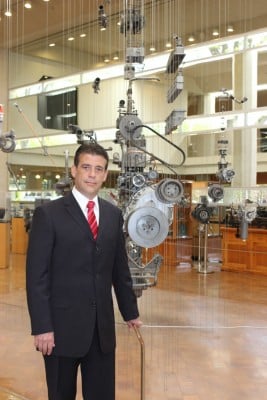
When I started at Cummins, I felt it was a good fit for me—and my background was attractive to them. I’m originally from the Dominican Republic and came to the US to study engineering at Michigan Technological University in the Upper Peninsula. I went from a nice beach to snow nine months of the year, but it was a great school. My degree is in mechanical engineering.
After college, I worked for Chrysler, Johnson Controls, and Delphi. Working in automotive was a good learning experience, but I wanted an industry with growth potential.
Cummins is a global power leader. It’s a corporation of complementary business units that design, manufacture, distribute, and service diesel and natural gas engines and related technologies. Our business units are engines; components, such as mufflers, filters, fuel systems, turbo technology; power generation for hospitals, data centers, etcetera; distribution; and our newest business unit, electronics. There isn’t a country in the world where you wouldn’t find our products. Over the last 10 years, our revenue has gone from $10 billion to $19.2 billion, and we believe we can reach $30 billion in the near future.
I am the corporate director for global logistics, which is a new position at Cummins. I am responsible for logistics, transportation, and warehousing across all of the business units. I work with the leaders of the business units. About 45 people report either directly or indirectly to me. In the past, each business unit had its own logistics team. Now we look at the whole enterprise.
My team supports the supply-chain function. Our supply chain vision is to establish reliable, market-driven supply chains to enable profitable growth for Cummins. We strive to be very customer-centric.
I also help develop new talent for the supply chain. Previously, a lot of the transportation work was outsourced. While we still outsource the actual execution, we are now managing how and when it should be done.
The focus of our chairman and CEO, Tom Linebarger, is profitable growth. We concentrate on five ‘growth accelerators’: adopting a growth mindset, developing from a multinational company to a global company, achieving supply-chain excellence, delivering customer support excellence, and investing in leadership development. Staying focused on these growth accelerators will help us compete effectively and achieve our targets.
In terms of the supply chain, to be successful globally, we need an enterprise-wide logistics system, one that features integration within and between the business units.
There are two revenue streams for our engines. One is OEM; most truck manufacturers in the US use Cummins engines. Recreational vehicles and buses also use our engines. The other is the off-highway market: excavators, earthmoving equipment, oil rigs. On the power-generation side, we sell to countries with diesel-generated electricity. Africa is a big market for us. Google is a big customer for back-up power—and hospitals as well. Cummins even supplied the power for the last World Cup in Brazil.
Eight out of 10 of our customers use Cummins engines and make some of their own engines. This represents an opportunity for growth—getting them to use more Cummins engines. Geographically, Africa and Australia hold great potential. There is a lot of mining in Australia, which represents a big potential market for our products.

One factor that works to our advantage is stringent emissions standards. Our products surpass all the latest EPA standards. Our growth over the last 10 years has been partially due to that. Customers switched to our products when their old products failed to meet the standards.
We’re constantly moving parts all over the world. There is no manufacturing facility that has 100 percent of its parts sourced in that country. If we don’t get products on-site on time, we can lose a customer. Suppose, for example, a mining company has to wait for parts. That downtime can be very expensive.
For many years, Cummins was multinational, but not global. In the past, if we needed to calculate something like company-wide spending on ocean freight, we had to get numbers from every business unit, each of which used its own providers. Now we’re doing strategic partnerships and creating a global network—using fewer providers and better coordination, which results in better prices and more efficiency.
Our engines, filtration, controls, fuel systems, and after-treatment make Cummins a leader in clean diesel technology. Our commitment to innovation has allowed us to deliver exceptional fuel economy to both our on- and off-highway customers. And we keep working to make our engines even more fuel efficient and further reduce CO2 emissions. We also support biodiesel development. All Cummins engines are equipped to run on a 20-percent blend of biodiesel with no adaptation required.
Playing a critical role in the supply-chain transformation journey. Without an effective supply-chain strategy, our growth would be limited. For example, during the recent work stoppages at the West Coast ports, some companies had to close to wait for parts. But we were able to keep operations going by rerouting materials through Canada and the East Coast. That’s rewarding.”

